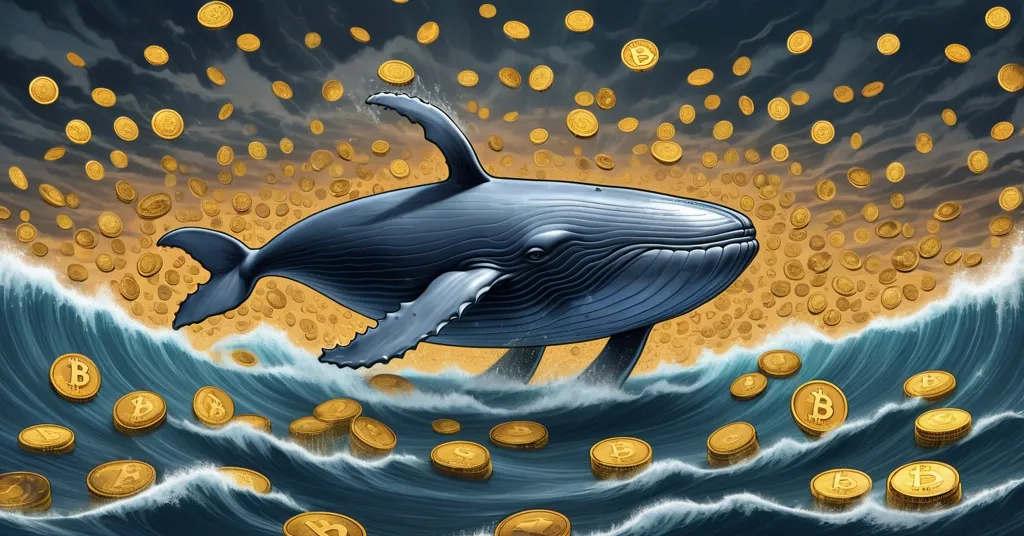Bitcoin Whale Dumps $616M After 13 Years—Market Impact or Minor Ripple?

Early Bitcoin Whale Dumps $616M in BTC After 13 Years—Market Shockwave or Non-Event?
A massive Bitcoin transaction has sent ripples through the crypto market as Owen Gunden, an early adopter holding since 2011, offloaded a jaw-dropping $616 million worth of BTC. This sale of 6,100 BTC, cutting his stash from $1.4 billion to $542 million, hits just as Bitcoin grapples with a stubborn $105,000 resistance and consolidates between $100,000 and $103,000.
- Huge Sell-Off: Owen Gunden sells 6,100 BTC for $616 million after 13 years of holding.
- Market Stalemate: Bitcoin stuck under $105,000 with solid support at $100,000.
- Mixed Signals: Analysts debate if whale selling hints at a dip or sets up a rally.
The Whale Who Made Waves
Let’s cut straight to the chase. Owen Gunden isn’t your average Bitcoin holder. He’s a whale—a term for individuals or entities with massive BTC holdings, often enough to sway market sentiment with a single trade. Since jumping in back in 2011, when Bitcoin was a niche experiment traded for pennies among cypherpunks and tech nerds, Gunden has ridden through every boom and bust. Now, with Bitcoin flirting near the psychologically charged $100,000 mark, he’s cashed out a chunk of his fortune. Thanks to on-chain sleuths at Arkham Intelligence, a blockchain analytics platform tracking wallet movements, we know the scale of this dump: 6,100 BTC, worth $616 million at current prices, leaving him with roughly $542 million in holdings. For more details on this massive transaction, check out the report on this early Bitcoin whale selling over $600M in BTC.
Why now? After HODLing—crypto slang for holding on for dear life—through over a decade of wild volatility, multiple 80% crashes, and life-altering gains, what’s pushing a veteran like Gunden to sell? Is it pure profit-taking after a 100,000x return, or does he see cracks in the market that the rest of us are blind to? Let’s unpack this with no fluff, diving into the market context, technical trends, and what this means for Bitcoin’s future.
Bitcoin’s Battle at $100K: Technicals and Trends
Bitcoin’s price action right now is a frustrating slog. Hovering between $100,000 and $103,000, it’s repeatedly failed to smash through the $105,000 barrier. Since mid-September, we’ve seen lower highs on the charts—a textbook sign of fading momentum. For those new to the game, lower highs mean each price peak is weaker than the last, often signaling potential downside if buyers don’t step up. Key resistance levels, where selling pressure tends to kick in, align with the 50-day and 100-day moving averages. Think of these as a rolling snapshot of Bitcoin’s average price over those timeframes, used by traders to spot trends. Support, where buying interest often emerges, sits at the 200-day moving average near $98,000, just below the critical $100,000 floor.
If that $100,000 level holds, some market watchers are betting on a recovery toward $110,000 or even $115,000. But if it cracks, a slide to $98,000—or worse—could trigger panic selling. Bottom line: Bitcoin is teetering on a knife-edge, and whale moves like Gunden’s aren’t helping ease the tension. For the everyday HODLer, these swings can feel like a gut punch to the portfolio, especially when big players seem to be heading for the exits.
Whale Pressure vs. Buyer Resilience
Gunden’s $616 million sell-off isn’t happening in a vacuum. On-chain data from Arkham Intelligence reveals a broader trend of whale activity adding to selling pressure. Large holders moving coins to exchanges often signal intent to sell, and that can spook smaller investors or stall upward momentum. Add in macro headwinds—think tightening liquidity as central banks hike rates, geopolitical unrest, and U.S. debt ceiling dramas—and risk assets like Bitcoin start looking less appetizing. Crypto isn’t fully decoupled from traditional markets, no matter how much we Bitcoin maximalists wish it were. When Wall Street stumbles, we often feel the tremors.
Yet, there’s a counterforce at play. Despite the whale dumps, buyer demand at $100,000 has been surprisingly stubborn. Someone—whether institutional players, savvy retail traders, or just die-hard believers—is soaking up the selling pressure. This tug-of-war has analysts split like a bad divorce. One camp sees this as late-stage distribution, where old whales offload to newer, weaker hands before a steeper drop. The other camp calls it reaccumulation, a shakeout of paper hands before the next big rally. Bitcoin’s history backs up both views: we’ve seen quiet consolidation before explosive runs, like the 2021 surge to $69,000, but also brutal corrections after whale sell-offs. Remember the Mt. Gox trustee dumps? Those stung hard.
Why Now? Unpacking Gunden’s Timing
Speculating on Gunden’s motives is a guessing game since no public statements are tied to this sale. Maybe it’s a pragmatic cash-out—turning digital gold into real-world wealth after a 13-year streak most of us can only fantasize about. Bitcoin bought at $1 in 2011 is worth $100,000 today; that’s a return justifying a yacht or two. Or perhaps it’s caution. Macro uncertainty, like central banks squeezing money supply or regulatory whispers of harsher crypto taxes, might spook even the diamond-handed. Could Gunden fear a crackdown on large holders or looming capital gains rules? It’s not far-fetched—governments worldwide are eyeing Bitcoin’s rise with a mix of curiosity and suspicion.
Here’s a devil’s advocate take: maybe whale sell-offs are overblown. Bitcoin’s market cap is over $2 trillion at current prices. A $616 million dump, while hefty, is a drop in the bucket—less than 0.03% of the total value. With growing institutional adoption (think BlackRock ETFs) and a maturing user base, are we giving too much weight to one whale’s move? Whales like Gunden don’t just swim in the Bitcoin ocean—they make waves, sure, but tsunamis? Doubtful. Still, for retail investors glued to every headline, it feels like a personal betrayal when an OG cashes out.
The Bigger Picture: Bitcoin’s Maturation
Zooming out, this event highlights Bitcoin’s evolution as an asset class. Whale transactions, dissected with laser precision by tools like Arkham Intelligence, are now a spectator sport for the crypto crowd. Every big move gets spun into narratives of doom or hopium, but the reality is messier. Bitcoin’s price is a messy stew of psychology, technical levels, and macro forces. No single trade, even a half-billion-dollar one, writes the ending.
Let’s not forget the fundamentals. Bitcoin’s network remains rock-solid—hash rate, a measure of mining power securing the blockchain, is near all-time highs. Adoption is creeping upward, from El Salvador’s legal tender experiment to Wall Street’s slow embrace. The upcoming halving, which cuts miner rewards and historically sparks price surges, looms on the horizon. These long-term tailwinds don’t vanish because one whale takes profits. For us champions of decentralization, freedom, and privacy, Gunden’s sale is a bitter reminder: Bitcoin’s road to disrupting the financial status quo is paved with volatility, not smooth gains. But that’s why we’re here—to ride the chaos toward a freer future.
Key Takeaways: What Should You Know?
- What does a Bitcoin whale sell-off mean for the market?
It ramps up selling pressure, as seen with Gunden’s $616 million dump, potentially dragging prices down or stalling rallies. Yet, strong buyer support at $100,000 shows market resilience, possibly blunting the impact. - Is Bitcoin’s current consolidation a bad sign?
Depends on who you ask. Persistent whale selling and lower highs suggest bearish risks if $100,000 support fails. Conversely, this could be a reaccumulation phase, where coins shift to new hands before a push to $110,000–$115,000. - What do technical trends hint about Bitcoin’s next move?
Resistance at key short-term moving averages caps upside near $105,000, while longer-term support near $98,000 waits below. Holding $100,000 could ignite a breakout; a breach might fuel more selling. - Why would a long-term holder like Gunden sell now?
Likely a mix of locking in massive gains after 13 years and hedging against macro risks like tight liquidity or regulatory shifts. It’s a practical play, not necessarily a bearish verdict on Bitcoin’s future. - Should retail investors worry about whale activity?
Not excessively. Focus on Bitcoin’s core strength—its decentralized network and growing adoption—over fleeting headlines. Whale sells sting, but with a $2 trillion market cap, no single trade defines the game.
What’s Next for Bitcoin?
So, where does Bitcoin head from here? If buyers defend $100,000 like a fortress, we might see the market shrug off this whale-induced turbulence and charge toward $105,000 or beyond. But if selling overwhelms, a dip below that psychological level could unleash uglier downside. Either way, Gunden’s move is a sharp nudge that Bitcoin remains a wild, untamed force—decentralized in spirit, yet still nudged by the heavyweights. For retail players, the takeaway is simple: zoom out. Don’t panic-sell on whale news, and keep an eye on fundamentals over fleeting drama. If whales are bailing, maybe they know something—or maybe they’re just bored of HODLing through another crypto winter. Bitcoin doesn’t care about their moods, and neither should you.



